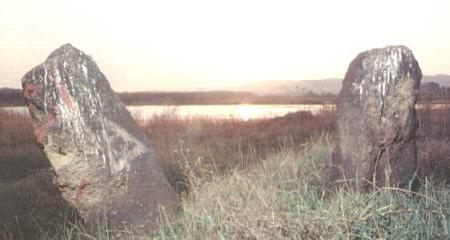D r o u ¾ k o v i c e (Co: Chomutov)
50°26´14,33´´N; 13°25´15,96´´E; 317 m ASL
The village located near Chomutov came into existence perhaps back in 11th century and was first mentioned in year 1314. It belonged to Chomutov dominion till year 1605, later on up until 1848 to Cerveny Hradec dominion. It was devasted completeley during thirty-year war but not ceased to exist. The character of the village was constantly agricultural. Throughout the entire period up until the end of World War II only the German inhabitants lived here. This has been confirmed by the name of the local stones called Generalsteine used also in the maps.
A square walled-up complex (from 5th century B.C.) almost as large as 1 hectare has been uncovered overhere where in the northwest corner thereof a large deepened house (6,5x7m) used to stand. Inside, a huge amount of ancient fragments along with bronzo plastic art forming apparently a feline that holds ram´s head in its jaws, was found (Etruscan influence). Most likely it is jar´s decoration that used to serve ceremonial purposes. In the area´eastern border yet another two earth-houses were found but that is all and no more structures have been found within the entire area. In both houses a blacksmith´s slag was discovered which testifies manufacturing activities had been carried out here, whereas findings that presumed trading life existed within normal courtyard are missing. Judged from the findings persons of significant positions must have had resided here.

We set out to Drouzkovice just to see where these two Generalsteine stones (maybe three originally) were standing. They have been embedded at the edge of sunken road (here I am using those reports disclosed already before) close to where field roads are fork-shaped at about the middle of the road between Drouzkovice and Chomutov. The Stones consist of coarse-grained rusty-brown Permian sandstone that comes from a distant location about 25 km away. Their height has equalled to 103cm and 90cm. Both Stones together have weighed round 300 kg. They have been located approximately in north-south direction, with their feets 64 cm away from each other, and their upper ends 115 cm distant from each other.

On the shapshot of Mr. Jan Pohrybny taken from tourist guidebook called Mysterious Menhires in Bohemia issued in 1995 you can see picturesque still-life with a quite pond level at the back. This pond is currently being filled up to close it out within the framework of land reclamation.
It is actually a bad example of non-sensitive approach towards nature and this historical monument as well which unfortunately is nothing that is considered unusual within Chomutov region. Neither the tradition nor local fame that have related to these Generalship Stones managed to help them (according to the legend they are the tombstones of three generals). Neither the civilians disgusted by this act could be of help. We would like to find out who are the guys to whom these Generalsteine Stones represented only the standing-in the way stones, and who has decided to carry them away to a landfill in Tusimice.
The stones used to stand in a noway elevated spot, but pointing towards southeast. When viewing over a church in the village one can see properly the headland of Dzban with Rovina where Kounov Stone Rows are found.


